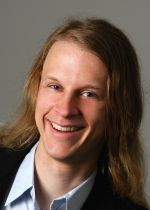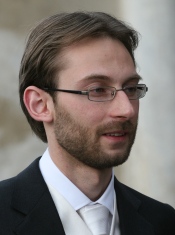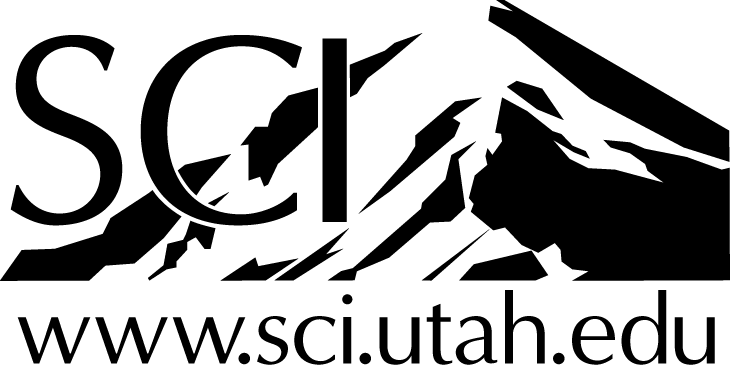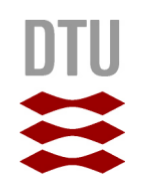Invited Speakers

Jonathan Shewchuk is an Associate Professor in the Department of Electrical
Engineering and Computer Sciences at UC Berkeley. He is best known for his
software Triangle for high-quality triangular mesh generation, which won the
2003 James Hardy Wilkinson Prize in Numerical Software, and his "Introduction
to the Conjugate Gradient Method Without the Agonizing Pain."
Talk abstract

Nic Smith is Professor and Head of Department of Biomedical Engineering at Kings College London and is also Visiting Professor of Computational Physiology at the University of Oxford. His research is characterised by the development of integrated multi-scale and multi-physics models mainly of the heart, which provide the ability to link biophysically detailed experimental data to integrated function from sub-cellular to the whole organ level. Within the scope of this work he has developed computational techniques to enable specific model developments that have in turn been applied to provide insight into cardiac physiology. His research has been focused on cardiac electrophysiology and contraction at the cellular level, and the multi-scale translation of these models to enable coronary blood flow, cardiac electro-mechanics and coupled tissue mechanics-ventricular blood flow simulations at the organ level.
Nic is currently a central contributor to the Virtual Physiological Human (VPH) Project sponsored by the European Commission working to develop integrated multi-scale computational models of organ systems. He has taken a leading role in promoting the significance and optimization of the connection between data and model parameters. He is the scientific coordinator of euHeart an FP7 Integrated Project focused on developing multi-scale, multi-physics cardiac models which involves 18 academic, clinical and industrial partners across Europe. In addition to euHeart he hold grants from the EPSRC, BBSRC, MRC as Principle Investigator and is an EPSRC leadership fellow.
Talk abstract

Michael Bronstein is an assistant professor in the Institute of
Computational Science, Faculty of Informatics, University of Lugano,
Switzerland. Previously, he had a visiting appointment in the Department
of Computer Science at Stanford university. Michael holds a B.Sc. from the
Department of Electrical Engineering in 2002 and Ph.D. from the Department
of Computer Science, Technion (Israel Institute of Technology) in 2007.
His main research interests are theoretical and computational methods in
metric geometry and their application to problems in computer vision,
pattern recognition, shape analysis, computer graphics, image processing,
and machine learning. He has authored over 70 publications in leading
journals and conferences, over 20 patents, and the book "Numerical
geometry of non-rigid shapes" (published by Springer Verlag). His research
was recognize by numerous awards and prizes and was featured in CNN, SIAM
News, Wired, and in the Abel lecture given in Oslo in honor of the 2009
Abel Prize laureate Mikhail Gromov. Michael Bronstein was the co-chair of
the Workshop on Non-rigid shapes and deformable image alignment (NORDIA)
in 2008-2011 and of the International Conference on n Scale Space and
Variational Methods in Computer Vision (SSVM) in 2011, and has served on
review and program committees of conferences in his field. In addition to
academic activities, in 2004-2009 he served as a scientist and Vice
President of video technology at the Silicon Valley start-up company
Novafora Inc, leading a team of researchers and engineers developing
Internet-scale computer vision and video analysis applications. Technology
developed by Dr. Bronstein has been used in the foundation of several
start-up companies, in which he is involved as advisor and co-founder.
Talk abstract
Best paper prize
There will be awarded a best paper prize. All accepted papers (orals and posters) are competing.
The winner is chosen by the organisers based on relevance, novelty and scientific contribution. The
award will be given at the end of the workshop.
Program
Each paper has 15 minutes for presentation and 5 minutes for Q and A.
| Time |
Activity |
| 8.50 - 9.00 |
Welcome |
| 9 - 9.45 |
Invited Plenary Talk: Jonathan Shewchuk |
| 9.45 - 10 |
Break |
| |
Session 1: Meshing.
Chair: Jessica Zhang |
| 10 - 10.20 |
Mesh-based vs. Image-based Statistical Appearance Model of the Human Femur: a Preliminary Comparison Study for the Creation of Finite Element Meshes.
Serena Bonaretti, Christof Seiler, Christelle Boichon, Philippe Büchler, and Mauricio Reyes
|
| 10.20 - 10.40 |
High-Quality Multi-Tissue Mesh Generation for Finite Element Analysis.
Panagiotis Foteinos and Nikos Chrisochoides
|
| 10.40 - 12 |
Poster Session |
| 12 - 13 |
Lunch |
| 13 - 13.45 |
Invited Plenary Talk: Nic Smith |
| |
Session 2: Medical applications of surfacing and meshing
Chair: Hervè Delingette |
| 13.45 - 14.05 |
MRI-free neuronavigation for transcranial magnetic stimulation in severe depression.
Benoît Combès, Charles Garraud, Xavier Morandi, Sylvain Prima, and Pierre Hellier
|
| 14.05 - 14.25 |
Shape based Conditional Random Fields for Segmenting Intracranial Aneurysms.
Sajjad Baloch, Erkang Cheng, Ying Zhu, Ashraf Mohamed, Haibin Ling, and Tong Fang
|
| 14.25 - 14.45 |
3D Surface Realignment Tracking for Medical Imaging: A Phantom Study with PET Motion Correction.
Oline V. Olesen, Rasmus R. Paulsen, Rasmus R. Jensen, Sune H. Keller, Merence Sibomana, Liselotte Højgaard, Bjarne Roed, and Rasmus Larsen
|
| 14.45 - 15 |
Break |
| 15 - 15.45 |
Invited Plenary Talk: Michael Bronstein |
| |
Session 3: Surfaces
Chair: Christian Barillot |
| 15.45 - 16.05 |
Example based style classiffication.
Katarzyna Wełnicka, Jakob Andreas Bærentzen, Henrik Aanæs, and Rasmus Larsen
|
| 16.05 - 16.25 |
Template Deformation with User Constraints for Live 3D Interactive Surface Extraction.
Benoit Mory, Oudom Somphone, Raphael Prevost, and Roberto Ardon
|
| 16.25 - 16.45 |
Automatic feature identification in dental meshes.
Yokesh Kumar, Ravi Janardan, Brent Larson, and Joe Moon
|
| 16.45 - 17 |
Best paper prize, discussion, and workshop closing |
Posters
- 3D Shape Analysis of the Knee Extensor and Flexor Muscles in Patients with COPD using Mesh Projection-based Features.
Hengameh Mirzaalian, Ghassan Hamarneh, Bahareh HajGhanbari, and W. Darlene Reid
- Geometric calibration between PET scanner and structured light scanner.
Martin Kjer, Oline V. Olesen, Rasmus R. Paulsen, Liselotte Højgaard, Bjarne Roed, and Rasmus Larsen
- CLARCS, a C++ Library for Automated Registration and Comparison of Surfaces: Medical Applications.
Alexandre Abadie, Benoît Combès, Claire Haegelen, and Sylvain Prima
- Automatic Statistical Shape Analysis of Local Cerebral Asymmetry in 3D T1-weighted magnetic resonance images.
Antonietta Pepe, Lu Zhao, Jussi Tohka, Juha Koikkalainen, Jarmo Hietala, and Ulla Ruotsalainen
- High Quality Remeshing of Closed Genus-0 Surfaces. Anton Semechko, Robert Dony, and Michele Oliver
- Development of Individualized Human Whole-body Thermoregulation Models Using Finite Element Analysis.
Tejash Patel, Gary P. Zientara, Xiaojiang Xu, and Reed W. Hoyt.
- An Atlas-Based Geometry Pipeline for Cardiac Hermite Model Construction.
Yongjie Zhang, Xinghua Liang, Jun Ma, Yiming Jing, Matthew J. Gonzales, Adarsh Krishnamurthy, Paul Stark, Sanjiv M. Narayan, and Andrew D. McCulloch
- Ultra Fast Optical Sectioning: Signal preserving filtering and surface reconstruction.
Rasmus R. Jensen, Mike van der Poel, Rasmus Larsen, and Rasmus R. Paulsen
- Approach-guided controlled resolution brain meshing for FE-based interactive neurosurgery simulation.
Michel Audette, Denis Rivière, Matthew Ewend, and Sébastien Valette
For poster presenters: The poster size should be a maximum of 120cm x 120cm.
The workshop will supply materials for mounting the poster (velcro dots).
The posters should be mounted in the Harbour Ballroom B Sunday morning 7:00 - 8:30. They are removed
by 3:45 pm (due to the reception).
 Jonathan Shewchuk is an Associate Professor in the Department of Electrical
Engineering and Computer Sciences at UC Berkeley. He is best known for his
software Triangle for high-quality triangular mesh generation, which won the
2003 James Hardy Wilkinson Prize in Numerical Software, and his "Introduction
to the Conjugate Gradient Method Without the Agonizing Pain."
Talk abstract
Jonathan Shewchuk is an Associate Professor in the Department of Electrical
Engineering and Computer Sciences at UC Berkeley. He is best known for his
software Triangle for high-quality triangular mesh generation, which won the
2003 James Hardy Wilkinson Prize in Numerical Software, and his "Introduction
to the Conjugate Gradient Method Without the Agonizing Pain."
Talk abstract
 Nic Smith is Professor and Head of Department of Biomedical Engineering at Kings College London and is also Visiting Professor of Computational Physiology at the University of Oxford. His research is characterised by the development of integrated multi-scale and multi-physics models mainly of the heart, which provide the ability to link biophysically detailed experimental data to integrated function from sub-cellular to the whole organ level. Within the scope of this work he has developed computational techniques to enable specific model developments that have in turn been applied to provide insight into cardiac physiology. His research has been focused on cardiac electrophysiology and contraction at the cellular level, and the multi-scale translation of these models to enable coronary blood flow, cardiac electro-mechanics and coupled tissue mechanics-ventricular blood flow simulations at the organ level.
Nic is currently a central contributor to the Virtual Physiological Human (VPH) Project sponsored by the European Commission working to develop integrated multi-scale computational models of organ systems. He has taken a leading role in promoting the significance and optimization of the connection between data and model parameters. He is the scientific coordinator of euHeart an FP7 Integrated Project focused on developing multi-scale, multi-physics cardiac models which involves 18 academic, clinical and industrial partners across Europe. In addition to euHeart he hold grants from the EPSRC, BBSRC, MRC as Principle Investigator and is an EPSRC leadership fellow.
Talk abstract
Nic Smith is Professor and Head of Department of Biomedical Engineering at Kings College London and is also Visiting Professor of Computational Physiology at the University of Oxford. His research is characterised by the development of integrated multi-scale and multi-physics models mainly of the heart, which provide the ability to link biophysically detailed experimental data to integrated function from sub-cellular to the whole organ level. Within the scope of this work he has developed computational techniques to enable specific model developments that have in turn been applied to provide insight into cardiac physiology. His research has been focused on cardiac electrophysiology and contraction at the cellular level, and the multi-scale translation of these models to enable coronary blood flow, cardiac electro-mechanics and coupled tissue mechanics-ventricular blood flow simulations at the organ level.
Nic is currently a central contributor to the Virtual Physiological Human (VPH) Project sponsored by the European Commission working to develop integrated multi-scale computational models of organ systems. He has taken a leading role in promoting the significance and optimization of the connection between data and model parameters. He is the scientific coordinator of euHeart an FP7 Integrated Project focused on developing multi-scale, multi-physics cardiac models which involves 18 academic, clinical and industrial partners across Europe. In addition to euHeart he hold grants from the EPSRC, BBSRC, MRC as Principle Investigator and is an EPSRC leadership fellow.
Talk abstract
 Michael Bronstein is an assistant professor in the Institute of
Computational Science, Faculty of Informatics, University of Lugano,
Switzerland. Previously, he had a visiting appointment in the Department
of Computer Science at Stanford university. Michael holds a B.Sc. from the
Department of Electrical Engineering in 2002 and Ph.D. from the Department
of Computer Science, Technion (Israel Institute of Technology) in 2007.
His main research interests are theoretical and computational methods in
metric geometry and their application to problems in computer vision,
pattern recognition, shape analysis, computer graphics, image processing,
and machine learning. He has authored over 70 publications in leading
journals and conferences, over 20 patents, and the book "Numerical
geometry of non-rigid shapes" (published by Springer Verlag). His research
was recognize by numerous awards and prizes and was featured in CNN, SIAM
News, Wired, and in the Abel lecture given in Oslo in honor of the 2009
Abel Prize laureate Mikhail Gromov. Michael Bronstein was the co-chair of
the Workshop on Non-rigid shapes and deformable image alignment (NORDIA)
in 2008-2011 and of the International Conference on n Scale Space and
Variational Methods in Computer Vision (SSVM) in 2011, and has served on
review and program committees of conferences in his field. In addition to
academic activities, in 2004-2009 he served as a scientist and Vice
President of video technology at the Silicon Valley start-up company
Novafora Inc, leading a team of researchers and engineers developing
Internet-scale computer vision and video analysis applications. Technology
developed by Dr. Bronstein has been used in the foundation of several
start-up companies, in which he is involved as advisor and co-founder.
Talk abstract
Michael Bronstein is an assistant professor in the Institute of
Computational Science, Faculty of Informatics, University of Lugano,
Switzerland. Previously, he had a visiting appointment in the Department
of Computer Science at Stanford university. Michael holds a B.Sc. from the
Department of Electrical Engineering in 2002 and Ph.D. from the Department
of Computer Science, Technion (Israel Institute of Technology) in 2007.
His main research interests are theoretical and computational methods in
metric geometry and their application to problems in computer vision,
pattern recognition, shape analysis, computer graphics, image processing,
and machine learning. He has authored over 70 publications in leading
journals and conferences, over 20 patents, and the book "Numerical
geometry of non-rigid shapes" (published by Springer Verlag). His research
was recognize by numerous awards and prizes and was featured in CNN, SIAM
News, Wired, and in the Abel lecture given in Oslo in honor of the 2009
Abel Prize laureate Mikhail Gromov. Michael Bronstein was the co-chair of
the Workshop on Non-rigid shapes and deformable image alignment (NORDIA)
in 2008-2011 and of the International Conference on n Scale Space and
Variational Methods in Computer Vision (SSVM) in 2011, and has served on
review and program committees of conferences in his field. In addition to
academic activities, in 2004-2009 he served as a scientist and Vice
President of video technology at the Silicon Valley start-up company
Novafora Inc, leading a team of researchers and engineers developing
Internet-scale computer vision and video analysis applications. Technology
developed by Dr. Bronstein has been used in the foundation of several
start-up companies, in which he is involved as advisor and co-founder.
Talk abstract

